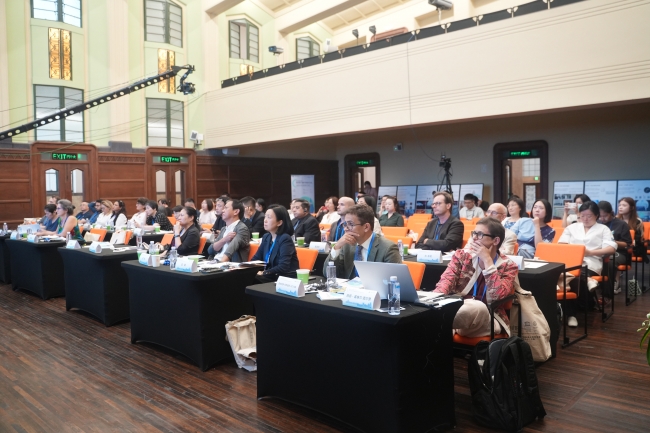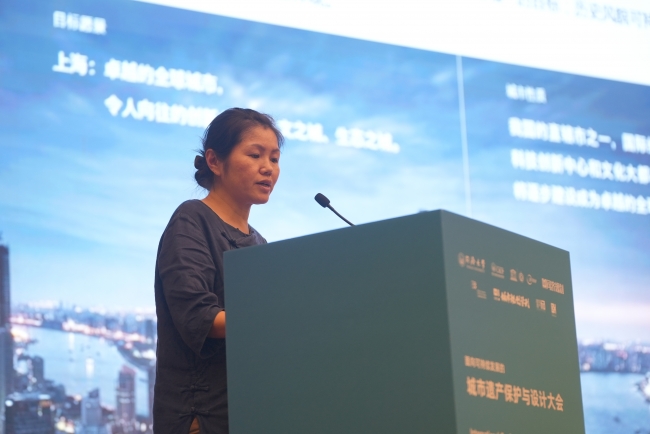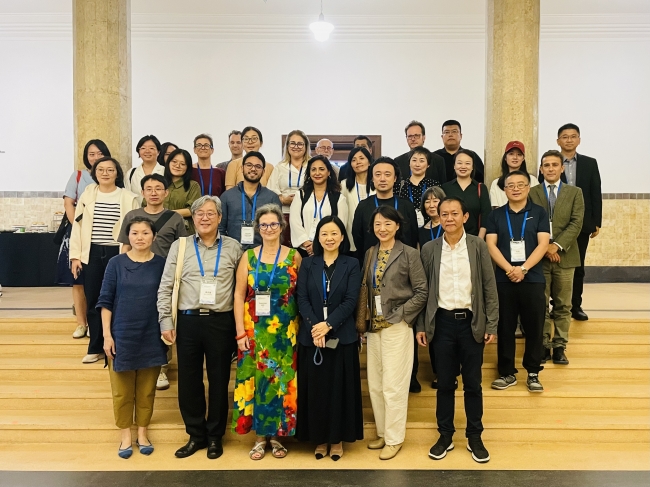| REVIEW | Summary of Keynote Speeches during the International Conference on Urban Heritage Conservation and Design for Sustainable Development |
| PublishDate:2023-10-20 Hits:3147 |
From 26 to 28 September 2023, the “International Conference on Urban Heritage Conservation and Design for Sustainable Development” and the first meeting on the establishment of the International Network for Urban Heritage Conservation in Higher Education Institutions were successfully held at the historic building of the former Lester Institute of Technical Education at Design Innovation Institute Shanghai and the Wenyuan Building at Tongji University campus. The conference was hosted by Tongji University and co-organized by the College of Architecture and Urban Planning (CAUP), World Heritage Institute of Training and Research for the Asia and Pacific Region (Shanghai), a Category 2 Centre under the auspices of UNESCO (WHITRAP Shanghai), and Shanghai Tongji Urban Planning and Design Institute Co., LTD (TJUPDI). The event was also presented as a forum during the 2023 World Design Cities Conference.   The conference comprises four sections: the opening ceremony, keynote speeches, three thematic sub-forums, and the closing ceremony. The keynote speech session on the afternoon of 26 September was moderated by Prof. Zhou Jian, Secretary-General of WHITRAP. Five speakers presented at the session, including Hu Min, Chief of Historical Famous City Conservation Division of Ministry of Housing and Urban-Rural Development of the People’s Republic of China, Prof. Michael Turner, UNESCO Chair holder in Urban Design and Conservation Studies and professor of Bezalel Academy of Arts and Design, Prof. Wu Zhiqiang, a member of the Chinese Academy of Engineering, German Academy of Science and Engineering and Royal Swedish Academy of Engineering Science, Ms. Françoise Ged from the Observatoire de l’arhitecture de la Chine Contemporaine Cité de l’Architecture et du Patrimoine, and Ms. Zhuang Qing, the Deputy Chief of the Preservation Department of Shanghai Planning and Natural Resource Bureau.
Chinese Famous Historical and Cultural Cities: the History and Future Prospects
 Hu Min
Chief of Historical Famous City Conservation Division, Ministry of Housing and Urban-Rural Development of the People’s Republic of China;
A professor-lever senior urban planner;
A registered urban planner;
A certified designer for cultural heritage conservation projects.
Mr. Hu Min, Chief of Historical Famous City Conservation Division of Ministry of Housing and Urban-Rural Development of the People’s Republic of China, presented a speech on the "History and Prospects of the Protection of Historical and Cultural Cities in China." Mr. Hu introduced the history and achievements of the preservation of famous historical and cultural towns and cities in China. Since the State Council announced the first list of Famous Historical and Cultural Cities in 1982, the country’s urban and rural historical preservation work has yielded remarkable feats. China’s President Xi Jinping has consistently highlighted the significance of safeguarding historical and cultural cities. He emphasized that such an effort should prioritize authenticity and integrity while being integrated into economic and social development. Furthermore, any measures should be executed with the utmost care and diligence, allowing for the preservation of both the city and its architectural features. The General Offices of CCCPC and of the State Council, released an Opinion on Strengthening the Protection and Inheritance of Historic and Cultural Heritage in the Course of Urban-Rural Development in August 2021. The Opinion is significant in terms of establishing new benchmarks, implementing novel concepts, and constructing a new mechanism. It corresponds with the 100th anniversary of the founding of the Communist Party of China, the building of a moderately well-off society, and the move towards high-quality urbanization. In his speech that followed, Mr. Hu elaborated the four principles to guide the protection of historical and cultural cities in the future: first, the protection should be based on a comprehensive understanding of the temporal and spatial continuity; second, we should respect and uphold the tradition while not limiting ourselves to the past; third, cities are a lively part of people’s life; and fourth, the vitality of culture lies in innovation. Mr. Hu came to the conclusion that in the new era, historical and cultural cities should serve as the catalyst for the development of the society. To achieve this, we should encourage the creative transformation and innovative development of historical culture so that the urban heritage acts as a vehicle for boosting the economy and improving the quality of life.
Beyond the Historic Urban Landscape in the Age of the Metropolis

Michael Turner Professor at Bezalel Academy of Arts and Design
UNESCO Chair holder in Urban Design and Conservation Studies
Prof. Michael Turner delivered a speech titled "Beyond the Historic Urban Landscape in the Age of the Metropolis", exploring the evolving urban heritage in the context of sustainable development. He presented the concept of "Heritopolis" and noted how, in recent years, the idea of heritage had evolved from being architectural monuments to include living cities and metropolises. He stressed the need for a wider recognition of the significance of the social, cultural and economic processes in the conservation of urban values. He cited the role of culture, the fourth pillar, as an enabler for sustainable development, exemplified by the changes expressed in the 2011 UNESCO Recommendation on Historic Urban Landscape and the 2030 Sustainable Development Goals. Furthermore, he mentioned the New Urban Agenda, adopted at Habitat III, and other related theories to expound on the connection between cities and culture. The term "Heritopolis," derived from "heritage" and "metropolis", reflects the correlation between heritage and cities. Heritage is not looking at the past, but it's in fact the creation of the future. As a result, it enhances the city’s resilience and liveliness, affecting the dynamics of its communities. Towards the end of his speech, Prof. Turner emphasized the importance of interdisciplinarity in relation to knowledge production and innovation models. He explained the five helices of the Quintuple Helix, which are vital for interactions and exchange of knowledge. Social change produces cultural change, which is essential in the generation of cultural heritage and the conservation of urban heritage. The future of urban heritage also relies on the advancement and cooperation of education, economic, political systems, the natural environment, and civil society.
The Intellectual Revival of Urban Life
 Wu Zhiqiang
Member of the Chinese Academy of Engineering;
Member of German Academy of Science and Engineering;
Member of Royal Swedish Academy of Engineering Science.
In his keynote speech, Academician Wu Zhiqiang shared his three insights on the intellectual revival of urban life through various case studies. First, he presented the idea that "city is a living organism, which needs to be taken care of", citing examples from his prior planning and designing work in Berlin, Paris, Hamburg and a sub-center of Beijing. Second, he proposed that "renovation should be precise and accurate by looking at the details", and underlined the importance of precisely identifying and distinguishing the genes and cells of each city in the process of urban planning. The primary genes of a city that doesn't change include the overall layout of its natural landscape, local traditional wisdom regarding how to treat the environment, and the city character and urban fabric. He then introduced the efforts his team has made to research ancient cities and their characteristics, including comparing the building heights, densities and floor area ratios between 22 typical Chinese ancient cities, accurately identifying road sections and streets requiring enhancement, and looking into the color patterns of a city. "In Chinese culture, compound medicines are always preferred over single-prescription medicines. The same principle applies to cities; only those with compound functions can truly embody a well-developed city and the vitality of Chinese civilization." Academician Wu used vivid analogies to highlight that the core of urban renovation lies in a comprehensive configuration. His third point emphasized that "renovation is beyond the physical". Renovation is for the benefit of people, rather than a superficial makeover. A city can be revitalized by smart renovation of its old areas. The ultimate aim is to promote the city’s prosperity. He also presented the “Taizhou urban Metaverse” project his team has created and the "Shaoxing - Ancient City Innovation Competition" as examples to demonstrate the importance of urban renovation for a more sustainable emergence of innovations. Academician Wu concluded, "The aim is to protect the genes and renew the cells of cities, and to revive the life. Efforts should also be made to enable digital empowerment of heritage and cultural empowerment of innovation, in order to ultimately improve the lives of people. These initiatives align with the SDG 11 of the United Nations on urban and community development". Caring for Places and People, Urban and Rural Heritage
 Françoise Ged
Observatoire de l’arhitecture de la Chine Contemporaine Cité de l’Architecture et du Patrimoine
Françoise Ged, the head of Observatoire de l’arhitecture de la Chine Contemporaine Cité de l’Architecture et du Patrimoine, presented on the topic of "Caring for Places and People, Urban and Rural Heritage." Initially, she introduced the "Cité de l'Architecture et du Patrimoine", a national cultural institution under the French Ministry of Culture opened in 2007 with the objective of constructing harmonious societies, buildings, and cities. The institution promotes exchange programs between French and Chinese architects, urban planners, and city services, which has established a number of collaborative programs with partners such as Tongji University and WHITRAP Shanghai. Following that, she introduced the concept of "landscape" in the context of urban heritage and sustainable development, tracing its historical origins and citing the outcomes of the International Conference on "Culture 2030: Urban and Rural Development" in Meishan, Sichuan Province in 2019. She emphasized that heritage worldwide, be it urban and vernacular, tangible and intangible, cultural and natural, are increasingly under threat. The very foundation of heritage lies in the act of passing it on. So the civil society and education have a crucial role to play to enable learning to care, to act together, and to connect past and future. She continued to present the French experience in heritage conservation, where various education programs for preserving heritage have been carried out. These programs, taking into account heritage in all its forms, built and unbuilt, formal and informal, aim to develop the necessary knowledge and its applications and to analyze, repair and adapt monuments, built ensembles and the landscape to contemporary needs. She also presented some best practices of sustainable architecture and urban planning in China. Finally, by citing the words of Alexander von Humboldt, she urged heritage practitioners to focus on fieldwork in order to discover a different perspective on the subjects, not to be confined to predefined categories or disciplines, and adopt new strategies to bring people and nature together.
Promoting High-quality Urban Renewal through Historical Preservation and Cultural Heritage Inheritance
 Zhuang Qing
Deputy Chief of the Preservation Department of Shanghai Planning and Natural Resource Bureau
Ms. Zhuang Qing from the Shanghai Planning and Natural Resource Bureau delivered a speech titled "Promoting High-Quality Urban Renewal through Historical Preservation and Cultural Heritage Inheritance". In three sections, the presentation provided a chronological overview of Shanghai's historical preservation and cultural heritage inheritance. Since being named as a National Famous Historical and Cultural City in 1986, Shanghai has implemented a city-wide protection system, established legislation to safeguard local heritage, developed a multi-level management system for conservation planning, and actively pursued the preservation and adaptive use of its historical heritage resources. During the first phase, which lasted from 1986 to 2001, Shanghai focused on the preservation of individual buildings and promoted legislation, as well as establishing the critical role of famous city conservation in the city's overall development strategy. During the second phase between 2002 and 2015, Shanghai started on a comprehensive mission to formulate regulations, and a management system for the point-to-point protection of "cities, towns and villages" as well as "points, lines and areas". The aim has been to protect these areas and their attributes and features in a holistic manner. In the third phase which spans from 2016 to the present, Shanghai successively integrated historical neighborhoods within their scope of protection as part of the efforts to enhance the concept of protection as a whole in the context of urban renewal, and to explore ways of promoting protection through use. Looking back at the development of Shanghai's historical preservation, successive sessions of municipal Party committee and government have placed a high value on the protection work, stressing the importance of coordinating development and protection, and have established a conservation mechanism for historical and cultural areas featuring comprehensive list of objects to be protected as well as measures of systematic management. In the new era, Shanghai, as a modern city steeped in history and culture, has a unique opportunity for high-quality development, but it also faces the serious challenge to strike a balance between historical spaces and the integration of new, contemporary functions. To achieve this, innovation and exploration are necessary to coordinate effective conservation and urban renewal so as to establish Shanghai as an example of historical preservation in a new era.
·END·
Contributed by: Conference Working Group Edited by: Yunyang Jiang(Intern) |
- Internship Opportunity | 2026 Spring Internship Recruitment for WHITR-AP Secretariat and WHITR-AP Shanghai
- News | UNESCO Will Release New Cases of the Urban Heritage Atlas
- NEWS | WHITR-AP Participates in UN-Habitat Forum
- Preview | WH Properties Assessment: An Overview Across The World
- Preview | Heritage Educational Landscape Exhibition Opening Soon
- Preview|1st UHC-HEI International Conference to open in Shanghai
Copyright © 2009-2012 World Heritage Institute of Training and Research-Asia and Pacific (shanghai)



